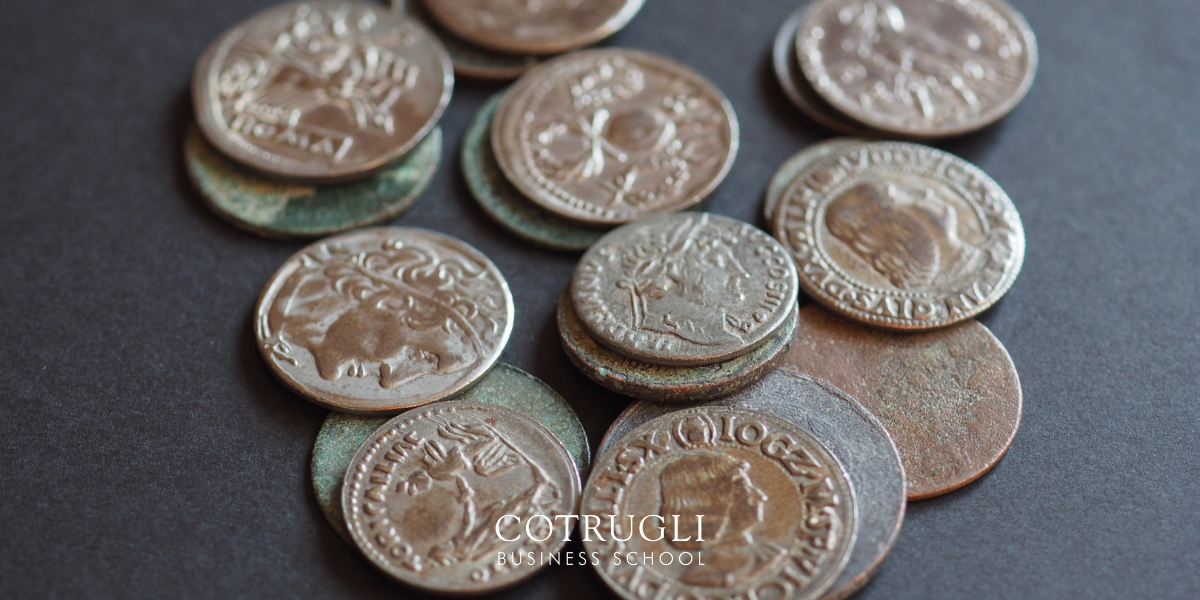
Well, How Do You Know?
07/01/2024
Amra Skrobo-Berberović, Esteemed COTRUGLI Business School Alumna, Receives Prestigious Marketing and Business Awards
08/01/2024
Banking in Ancient Times: Functions and Practices
In ancient times, bankers performed a wide range of services. They tested and exchanged coins, accepted deposits of money and valuables, facilitated loans, and conducted other essential financial tasks. While some bankers specialized in certain areas, their roles often overlapped.
Coin Testing and Verification
One of the oldest functions was coin testing, known as probatio nummorum. Bankers were well-suited for this task due to their expertise in handling money. To verify gold coins in particular, they used touchstones and relied on sensory techniques. They inspected a coin’s appearance, tapped it to listen for the correct sound, and checked its size and minting origin.
To weigh coins, they used a small balance scale called a tratina, designed for handheld use. These procedures helped ensure coins weren’t counterfeit or worn down from use. Since the Roman Empire was more unified than the Greek city-states, the need for currency exchange was lower. However, converting large-value coins into smaller denominations or swapping local currencies remained common.
The Evolution of Banking Services
Over time, Roman bankers (argentarii) adopted the use of bills of exchange to enable cashless transactions. This practice, called permutatio, allowed them to transfer money without moving physical coins. For example, a banker in one city could accept funds and issue a bill payable in another, relying on a trusted network of counterparts.
These operations required knowledge of exchange rates and strong relationships with other bankers. The system reduced risk and simplified long-distance trade.
Banking and Public Auctions
Bankers also played a key role in commerce and auctions. Auctions took place in markets, ports, and fairs. They were used to sell goods from estates, defaulting debtors, or general merchandise to the highest bidder.
A special group of bankers, called coactores argentarii, managed auction records (tabulae auctionariae). These included dates, item descriptions, sale prices, and the names of buyers and sellers. They also handled payments, advanced short-term loans, and filled in when either party was absent. Their role as intermediaries was crucial to the smooth running of public and private auctions.
Deposits, Payments, and Lending Practices
Bankers accepted two types of deposits. A simple deposit, known as depositum, was used for safekeeping and did not earn interest. These were referred to as vacua pecunia or “idle money.” In contrast, a timed deposit, or creditum, allowed the banker to use the funds and pay interest to the depositor.
Bankers also facilitated payments through a system called per mensam. With the depositor’s authorization, payments could be made in cash or transferred between accounts (rescribere). This process laid the groundwork for what we now know as bank transfers.
Lending and Interest Rates
Lending was a core part of banking, and it generated significant profits. During the late Republic and early Empire, interest rates typically ranged between 6% and 10%. However, riskier loans—especially those made in remote provinces or for maritime ventures—could command higher rates. Over time, the centesima, or 12% annual rate, became a standard benchmark across the Roman financial system.




